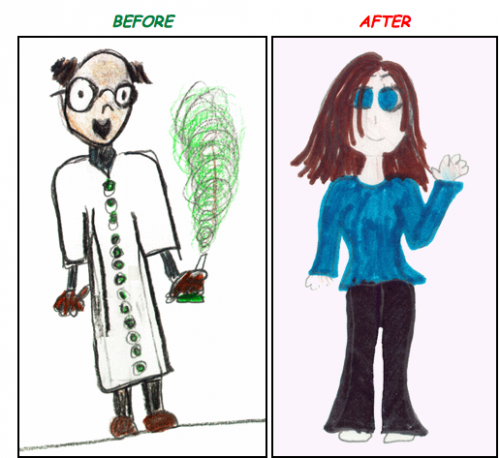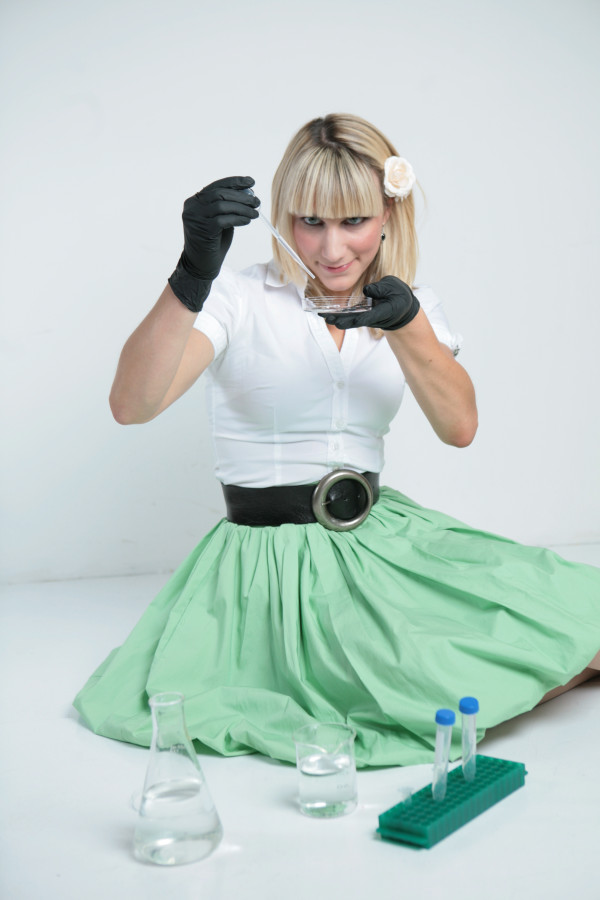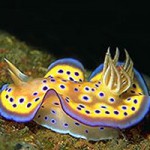Glamour magazine, where the HELL are female scientists in your annual “women of the year” awards?
Year after year, you honor female actresses, fashion designers, politicians, activists, athletes and models. You bestow awards on some truly amazing people, who have made it their life’s work to change the world and spread messages of peace, hope, and joy. When have you ever even mentioned science?
Day in, day out (and often all through the night) a veritable army of female scientists are working their assess off in labs across the world. We don’t do it for the money—we work because we believe in something greater than ourselves, believe that one day our small steps in knowledge will revolutionize our understanding of the natural world or translate into huge medical advances.
Glamour is the magazine our children and neighbours read. They certainly aren’t sitting down with the latest copy of Science. Hell, they probably aren’t even reading our colloquial science-y musings at Deep Sea News, but we’re working hard to change that.
Glamour, I’m begging you: if you don’t honor women scientists as Women of the Year, how will people even KNOW that science even EXISTS as a career option?
Is it because society sees scientists as this?

Instead of this?
My sister’s high school friends don’t have aspirations to become a stuffy, boring intellectual (trust me, I’ve had this conversation with them). We can only empower younger generations if we show them ALL of the paths that exist for them. And right now, science isn’t even on the map.
I have made it my life’s mission to change the public perception of science.
And at Deep Sea News, we’ve made it our mission to expand the culture of ocean science.
The oceans are deeply ingrained in human culture. Scientists are fundamentally human. Here at Deep Sea News, we have strengthened our resolve – we are determined to highlight areas where the ocean touches our society, and to provide a window into our lives as both scientists and members of this broader society. We will strive towards a future that allows for scientists and the public to be partnering stakeholders in sustaining and preserving our oceans.
Us researchers know that science is dynamic and interactive – full of passion and drive. Our colleagues have PERSONALITIES – we work with unique, intelligent people that are always a far cry from the dry, boring (old white guy) stereotype. I’m a marine biologist who reads Vogue and teaches yoga in my spare time.
But changing the culture of science doesn’t just mean reaching out to the public. It means convincing scientists to build and maintain a high public visibility—leveraging blogs and social media is lucrative and worthwhile. Engaging non-scientists isn’t an option. In today’s world, it is a necessity. And, contrary to popular belief, this type of outreach doesn’t compete with your research—on the contrary, it enhances and broadens your traditional scientific portfolio.
Right now, I swear the science world is just like the fashion world. In the words of Heidi Klum, “One day you’re in…the next day you’re out”. And in the cutthroat fight for tenure, you never want to be asked to leave the runway.
Getting published in the highest impact journals is like getting a front row seat during fashion week. You put your head down, lock the doors, and work your ass off in hopes of one day securing that golden ticket. If you’re lucky, some mysterious group (Nature editors!) decides that your research is So Hot Right Now, and BOOM, ticket in the mail (manuscript accepted!). Sometimes you look at who is there and you’re confused and annoyed – really? Snooki got an invite to Missoni? (Nature’s table of contents is full of Mouse T-cell interleukin binding factor WHAT?).
With the intense job competition and tight race for funding, I feel like us early career researchers have two options: We can quietly work hard, chasing high-impact papers or becoming really good at something like taxonomy, but realize that we will be forever cramped in a closet office and lack recognition for the first 30 years or so, OR we can become the Lady Gagas of science. Sure, your eccentricity and unconventional ways may turn heads and boil some blood. But behind the gossip and chatter, you make really f*#*%ing awesome music (innovative, thought-provoking science). Lady Gaga not only gets a front row seat at fashion week, but she gets people talking and gets people excited. By reinventing the notion of a pop star, she has defined new paradigms for the entire music industry.
At Deep Sea News, we’re defining new rules for the next generation of scientists. The public will tear down the Ivory Towers with their own bare hands.
Yes, I am sitting here, alone in a room, venting out my frustrations though a computer—ranting online and hoping someone will notice. But you’re dead wrong if you think this will be the end of it.
_______________________________________________________________________
UPDATE: Thanks to everyone for all the fabulous discussion and thought-provoking comments. I just wanted to follow up with a clarification and a few further points
I’m not saying we should just go and glam up science. Running a glossy PR campaign might get people to take notice temporarily (and spur heated arguments), but it isn’t addressing the deeper root of the problem. Personally, I’m not one to get involved in these type of debates – everyone has their own opinion, often there is no right answer, and fruitless anger is a waste of my time and energy.
In my view, making scientists visible is about redefining what we value and how we function as a society. With a stagnant recession and climate change on the horizon, we cannot AFFORD to keep putting on blinders and recklessly forging ahead. You want to create jobs? You want to build a sustainable future? Invest in science and technology.
Grad students and postdocs are some of the most engaging and enthusiastic people I’ve met, but in terms of salary, benefits, and workload they are oftentimes treated like slaves. I have friends in Manhattan who work as secretaries and get paid almost double my salary–is that right? Given the way we currently treat scientists, what does that say about what our society values? A system that beats down its most promising trainees, either forcing them out (due to financial constraints, etc.) or forcing them to produce only what the system wants (high-impact papers), is fundamentally flawed. The system also places a perpetual barrier between researchers and all other non-scientists. A public that mistrusts researchers is not well informed about how science works.
I’m lucky that my PI is supportive of me blogging on the side, but I know that many researchers would not tolerate it and/or would constantly worry that it is interfering with their scientific productivity. But that brings us back to the issue of how we measure “productivity” in today’s technology-driven world.
Yes, there are a lot of people swimming in the Ph.D. pool, and far fewer academic jobs. Academia will always be competitive, and if you’re set on that career path you need to be fully aware of what the game entails. Going through grad school won’t be easy, being a postdoc isn’t a walk in the park. But not everyone who likes science has to go into academia! Not everyone needs or wants a Ph.D. The scientific thought process can be so inherently beneficial for EVERYONE, on both a personal and professional level: Knowing how to assess and find trustworthy sources of information, examining all the available facts, thinking about them critically, and then placing them in the context of your personal experiences and opinions.
What I’m advocating is that we just need a greater awareness of scientists in general. We exist! We aren’t boring! You can talk to us about normal stuff! We’re as passionate and driven as any actress or rock star. For us insiders (academics, grad students, etc.), we all know that “stuffy scientist” image is definitely not true. But ask a random 7 year old what a scientist looks like, and guess what picture they’ll draw? The crazy old guy. The ubiquity of that stereotype is deeply disturbing:
Students’ views of science and scientists have been widely studied. Classroom learning environment has been found to play a major role in these perceptions. High school students often have a stereotypically masculine image of science and view scientists and scientific work as unpleasant entities. To examine where students develop their images, children have been asked to draw pictures of scientists. Most drawings portray a scientist as an elderly male wearing a white coat and glasses. However, teacher intervention programs have been shown to be effective in helping to alter these negative images (Mason, et al. 1991). [from the National Science Foundation website]
And then there’s this – a study where kids were asked to draw pictures of scientists before and after their classroom was visited by actual researchers.

The “after” pictures look like the scientists I know. But look at those “before” pictures!! As much as we scientists don’t want to admit it, we spend our entire lives locked in an Ivory Tower. The barrier between scientists and non-scientists is stark and tangible. Treebeard needs to get his ass down to Isengard and rip down that thing down, stat!
So no, we shouldn’t all scramble to be high-visibility Gagas – I’ll happily volunteer to fill that role. If we can’t convince the system to change, we need to change our own approach. Deep Sea News isn’t a traditional approach in science, but we Deeplings have all experienced a multitude of scientific benefits from using this blog as a platform. We will make the collective of voices grow. We will redefine the status quo.







Well said. Very well said.
I am in awe of your badassery. :)
Wonderful piece, and fabulous picture! Love the black nitriles.
But…I am left wondering if glamming up science purely for the sake of encouraging budding young scientists is a good idea. Instead I feel like we should be engaging non-scientists. As all of us in grad school/post-doccing/somewhere along the tenure track know, there is a pretty glaring shortage of jobs for PhD-holders. Is it a good idea to encourage young and enthusiastic minds with the promise of intellectual success without pointing out the very real financial and professional pitfalls that likely will hit in their late 20s?
It would also seem to me from the vast number of cool and interesting scientists I’ve met that somehow the image of the “stuffy scientist” is actually gone from those pursuing a career in science. Either they have seen through the lie, or did some digging and realized that that image is indeed a lie.
So, basically my point is that you are absolutely right: Scientists need to be vocal and noticed and true to who they are and not unfairly pigeonholed into the boring intellectal category. BUT perhaps we should focus on appealing to the lay-person and not just those who show an interest in what we do?
Just what *is* that colorless liquid you’re pipetting so devilishly?
Also, right on!
Maybe we need something other than peacock feathers. Maybe trying to be Lady Gaga, bless her crazed and generous heart, is not really the solution. By definition, the world can only support a couple of people who are truly outrageous and yet still successful. And science is less and less about lone geniuses, and more and more about a collaborative effort.
The scrambling for high visibility within science is a problem, not a solution. Seeking public visibility is a good idea, and the idea that scientists have to be stodgy is pretty unrealistic, true. But if you manage to attract a bunch of glamor to the scientific career path you will be doing the impressionable youth no favors, as the career path is increasingly fraught with more risk and yet offers less reward than it once did.
So this Gaga approach dances around the real problems. I am happy to do outreach about science, but that means selling the ideas of science, not the career path. I am not willing to promote the idea of being a scientist or pretend it is a whirlwind of fun. The practice of science is not for everybody, and is not especially intrinsically glamorous, let’s face it.
You can of course be an amazing personality and an extrovert and a scientist at the same time. More power to you. But I don’t think connecting these things into a pop-star system is actually going to fly, and if it does, I don’t think it will help much.
I have the amazing opportunity to teach high school science at an all girls school in Charleston, SC! My life’s mission is to make my ladies excited about science and see how it applies to their daily lives in hopes of incorporating it into their future! Thank you for getting the message out, I also have had the opportunity to work with many ladies who inspire our young ladies to love science!! Touche and thank you again!!
Heh. Noticed. I just checked my G+ stream and I think every scientist in my circle shared it :)
Testify, sister.
I think the bigger point Holly might be trying to make is that it is OK to be YOURSELF with all your eccentricities and be a successful science. Potential scientists may be turned off by the stereotypes of what one is and does.
Showing that we can be ourselves (and hey, maybe some of us are just stuffy old white guys, right?), have a life outside of a career and do a variety of things while having a career as working scientists – academic or otherwise – might do a lot to alleviate this grand misunderstanding.
Its part of the outreach package, not necessarily the whole outreach package. But this goes with her greater point of changing the culture of science. It shouldn’t be confined to a small set of personality types. This is probably part of why so much science is, frankly, boring… Oh yeah another set of deep-sea data points not put into a greater context of who gives a fuck… yeah…
peacock feathers:
Using paradise bird feathers for hat production led to the first political ‘gender’ movement in Germany… and to the foundation of NABU, the first green movement & organisation…
http://ed.iiQii.de/gallery/Querdenkerinnen/LinaHaehnle_nabu_de
Wonderful post! And I want to wear that outfit to my lab one day hahaha.
Maybe I spend too much time with other scientists so I’m totally insulated about what other’s perceptions of scientists are, but I’ve never met anyone like the first scientist pictured. On the other hand I have to say that your second picture looks like most of the female microbiologists and biochemists I’ve met. In fact I’d say they are as a whole the most fashionable scientists I’ve ever seen. Ecologists on the other hand…but that’s another subject ;). I’m curious though, why do you say that the public’s perception of scientists is the former picture? I’ve never introduced myself as “a scientist” and had people say “You look so normal”. Is it because there were no scientists in Glamour or are there other reasons? I checked if this was a gender bias, but GQ also named no scientists in their “men of the year” http://blog.zap2it.com/pop2it/2011/11/gqs-men-of-the-year-jay-z-justin-timberlake-michael-fassbender-and-umm-mila-kunis.html. Broad scale evidence contradicts your assertion that there’s a negative perception of scientists preventing younger people from becoming scientists. Here’s an example, if you examine the raw data from the NSF survey of doctorates, you’ll see that the number of PhD’s awarded in our field of “life sciences” has increased from 5,276 in 1979 to 11,392 in 2009. I thought maybe this was a result of population growth but taking that into account, you find that in 1979 there were 23.44 PhD’s in the life science awarded per 1 million US citizens, and by 2009 that had jumped to 37.35/million. On top of that in the life sciences 54.5% of those PhD’s were women (http://www.nsf.gov/statistics/nsf11306/appendix/pdf/tab12.pdf), so perhaps in talking to your sisters friends it seems this way, but overall it appears that a larger and larger fraction of the US population is getting a PhD in life sciences (but this trend holds up over other STEM careers).
But another point is that its hard to put a public face to ourselves in our professional lives. I do lots of things other than science, I rock climb, backcountry ski, I love to sail and I’m in a summer kickball league where we decide who kicks first each week by shotgunning beers after a crab race around the bases. But that’s not what the small number of people who read my blog necessarily want to know about me, or why they read my blog. I want people to read it and think “that’s a sharp dude”. While I totally agree with you that its important to have a public face, and a publicly accessible face at that, I’m not sure the motivating factor behind that should be to change a public perception of science that doesn’t seem quite as askew as you suggest.
Hell to the yes! I would say I’m bringing animal print back, but let’s face it, it’s never really been gone from at least 1950 to present. A PBS film crew is visiting my lab next week, so I’ll be doing my part to dismiss the ‘old white guy’ scientist stereotype!
I’ve had at least one person mention that their friends envisioned them running around a lab in a long white coat….perhaps not as bad as the picture suggests, but still much more uptight than the atmosphere I actually work in.
The change is happening.
My daughter, twelve, loves cats, loves pink, and dances ballet.
She also has a telescope and a chemistry set, and can hold forth (at some considerable length) about Plutos planetary status.
She watches Myth Busters and Warped after school, and is teaching herself to use a sextant. She gets high marks across all subjects, but loves math and science the most.
I think you may have sparked something: lab coat green may be the new black!
But keep expressing and telling us what you’re doing, because I am following you! (I don’t follow fashion nor pop music.)
I don’t know about emulating our sort of debased popular culture….I think science itself is its best ambassador among the young.
I do know that enthusiasm for science among well-educated grade-school teachers goes a long way toward getting the science ball rolling among children of both sexes. My late husband was a physician and hematologist who ran a basic science lab at a renowned medical research institution here in La Jolla CA. There was one woman PhD in his lab. His granddaughter, now in fourth grade local public school, had a third grade teacher from England who knew a lot of science and incorporated it into the curriculum, including fielding student teams four times a year at a local science olympiad called Rendezvous Engineering Math & Science. REMS has been happening at La Jolla High School under the aegis of a remarkable science teacher there — aptly named Martin Teachworth. Last night’s REMS gathering of kids from grades 3 – 12 required an overflow hall in the cafeteria for grownups because the kids had filled the auditorium.
The key to girls in science is the same as for boys in science: greater exposure and learning enough to love the subject.
Ed. note: corrections made to above comment as per commenter’s request
I love this article! I am 17 and interested in intrinsic health and other nutritional matters. I also wrote a fiction story for a homeschool project that touted conservation, and it has now been published as a children’s book.
Thank you for the shout-out. Glamour magazine better listen!
well, it could be worse. at least there isn’t a “people of the lab” website like the people who shop at wal-mart site…or is there? i got my degree in history. we don’t fair much better.
Keep science cool, interesting and of course glamorous, DepSeaNews! Yes, there may be a glut of Ph.D.’s but one learns skills that can be transferred to so many other disciplines. Those of us who teach are always finding ways to show the importance of understanding science in our daily lives.
Or for that matter women in Business or Healthcare?